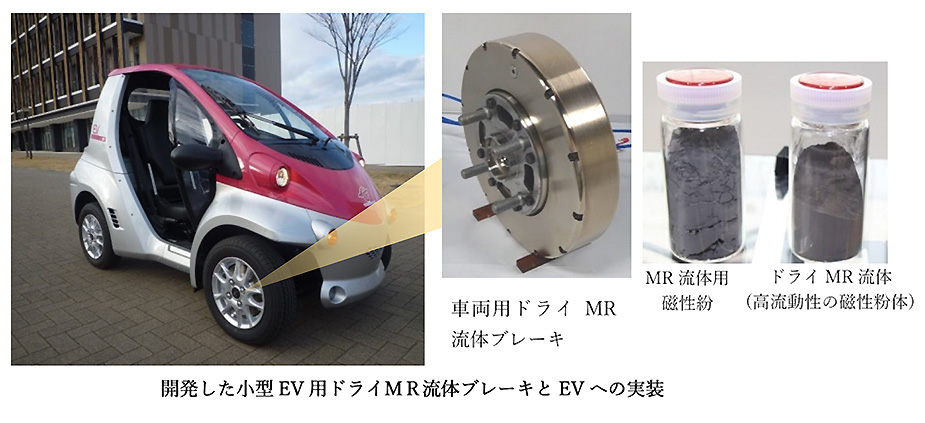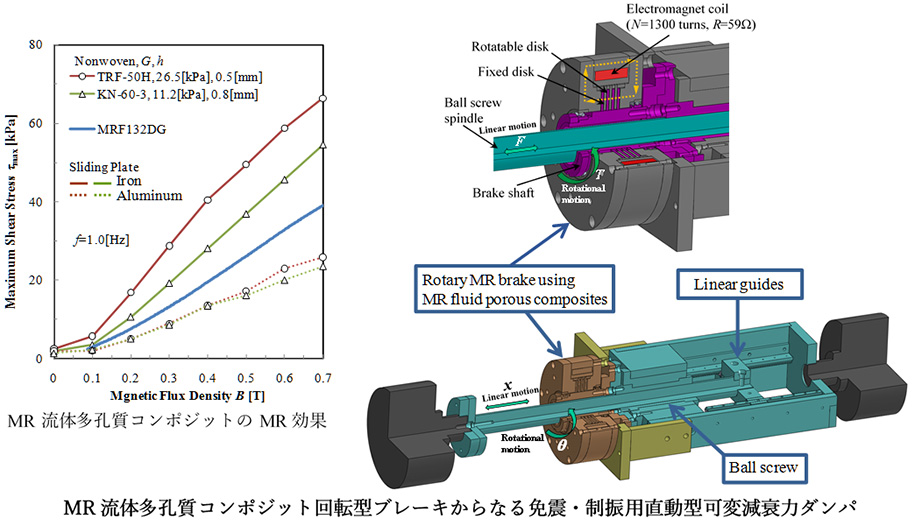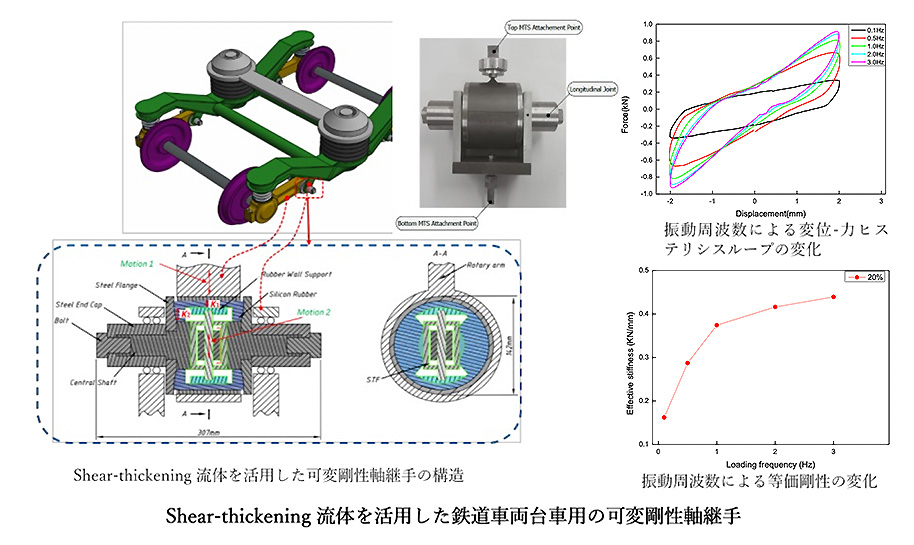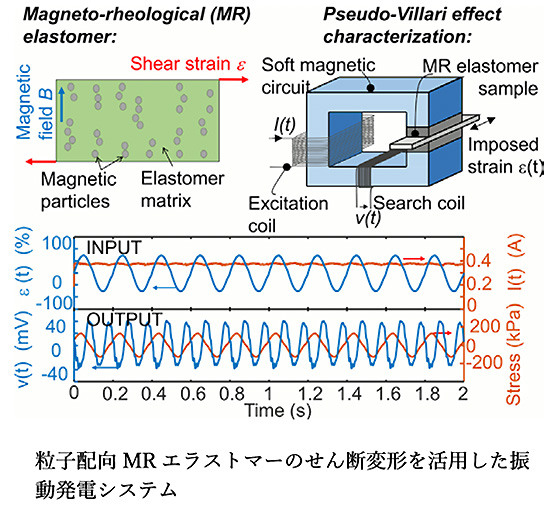Projects
Development of Advanced Smart Fluids & Soft Matters and the Device Applications
Name
Masami Nakano
Specially Appointed Professor
Pesearch project: “Advanced logistics transport systems”
New Industry Creation Hatchery Center (NICHe)
Outline of Research
We will develop advanced smart fluids and soft matters of which physical properties like viscoelasticity, and electrical and magnetic properties, change in response to electric and magnetic fields and external forces. We will utilize these smart materials to create highly functional devices such as dampers, brakes, clutches, actuators, sensors, and vibration-energy harvester, leading widespread practical implementation in various systems such as general industrial machinery, vehicles, and robots.
Research Purpose
We will research and develop advanced smart fluids and soft materials whose physical properties like viscoelasticity, and electrical and magnetic properties change in response to electric and magnetic fields and external forces. In this project, we aim to create highly functional devices that take advantage of the unique functionality of these smart materials and to attain widespread practical implementation of these devices in various systems, including general industrial machines, vehicles, and robots.
Expected Effect
Smart fluids and soft matter include ER (electro-rheological) fluids and MR (magneto-rheological) fluids, whose viscosity changes significantly when an electric or magnetic field is applied. These fluids have also led to the recent creation of MR fluid porous composites, dry MR fluids (oil-free high-fluidity powders), MR elastomers, and shear-thickening fluids. We expect to develop highly functional devices that utilize the unique functions and features of these fluids and soft matter, such as dampers, brakes, clutches, actuators, sensors, and vibration-energy harvester. We also expect to implement these new highly functional devices in various systems such as general industrial machinery, vehicles, and robots.
We have obtained the following research achievements mainly through industry-academia collaboration.
- We have developed a vehicle brake that uses MR fluid as the working medium, of which viscosity changes significantly when a magnetic field is applied. After installing it in the four wheels of a super-compact EV to build a brake-by-wire system, we have evaluated its braking performance and ABS control, resulting in the demonstration of the brake’s flexible controllability and quick response, and the development of this system to a practical level.
- We are developing high fluidity, high MR-effect, high performance oil-free dry MR fluids (magnetic powders that exhibit high fluidity) for use in relatively harsh operating environments. One feature of our dry MR fluid is that it can be used stably in both extremely low and high temperature environments ranging from -50°C to 160°C. Taking this advantage, we have developed a vehicle brake which uses dry MR fluid as the working medium. We have evaluated the brake performance by constructing a brake-by-wire system installed in the four wheels of a super-compact EV. This evaluation demonstrated that the brake was robust in a wide range of thermal environments and had flexible controllability and quick response. The brake is now being developed to a practical level.

- We have created MR fluid porous composites by impregnating MR fluid into porous materials such as non-woven fabrics. We are taking advantage of the features of this composite—its high MR effect and anti-sedimentation of magnetic particles dispersed in the MR fluid—to develop a linear-motion damper for seismic isolation and vibration control in building structures. The damper consists of a ball screw that converts the linear motion of the damper into rotational motion, and a rotary brake utilized the MR fluid porous composite that provides braking torque to the converted rotational motion. We have demonstrated that the damping performance of this damper is almost identical to that of an MR fluid damper using a conventional MR fluid.

- We are working on a variety of technologies with the goal of improving vehicle-system stability and ride comfort. We are developing a rubber axle joint with a built-in damper utilizing shear-thickening fluid (STF) to improve the stability of train bogies operating on curves. We are also working on MR fluid dampers and support-spring suspension systems equipped with nonlinear negative stiffness generator composed of two permanent magnet pairs to improve vehicle ride comfort.
As the STF has the characteristic of a rapidly increasing viscosity when the STF exceeds a certain shear rate, the shear-thickening fluid rubber joint has been clarified to have variable stiffness function according to vibration frequency, which improves the stability of train bogies operating on curves.
In addition, we compared the MR fluid damper and support-spring suspension system equipped with a nonlinear negative stiffness generator consisting of two permanent magnet pairs with the performance of conventional suspension systems. By applying fuzzy control, this system provides not only damping, but also variable stiffness. We were able to demonstrate that this new suspension system has remarkable vibration-control performance, compared with conventional oil damper-passive-suspension systems, and to semi-active suspension systems using MR fluid dampers.

- We developed an MR fluid clutch to be installed between the drive motor and the driven rotary machine, and we have conducted tests on actual machines to demonstrate that this clutch can provide excellent variable speed control. We are also developing a production-level prototype.
- To fabricate novel high-performance MR elastomers with variable stiffness, we have developed a variety of MR elastomers by dispersing ferromagnetic particles in matrices such as silicone rubber and solidifying them. To apply the MR elastomer’s variable stiffness for the local surface-pressure control device of the polishing head, we have developed a prototype of a locally distributed magnetic field applicable device. This device consists of several segments which can apply a locally distributed magnetic field to the MR elastomer sheet, thus enabling control of local surface pressure. We have demonstrated that the surface pressure of the sheet can be increased locally by applying a locally distributed magnetic field to the sheet using the distributed magnetic field applicable device, and we are attempting to build a prototype polishing system that can control local surface pressure.
- We have discovered that the permeability of particle-oriented (anisotropic) MR elastomers changes significantly with shear deformation. This unique characteristic was applied to develop a vibration-energy harvester that converts vibration energy into electrical energy using Faraday’s law of electromagnetic induction.

Keywords
Magnetorheological (MR) fluids, MR fluid porous composites, dry MR fluids, MR elastomers, shear-thickening fluids, brakes, clutches, dampers, actuators, vibration control, vibration-energy harvester, seismic isolation and vibration control, vehicles
SDGs
Contact Information
TEL:+81-22-217-3848
E-mail address: masami.nakano.b2*tohoku.ac.jp
Please use @ instead of *.
HP: 未来科学技術共同研究センター 研究者リスト
